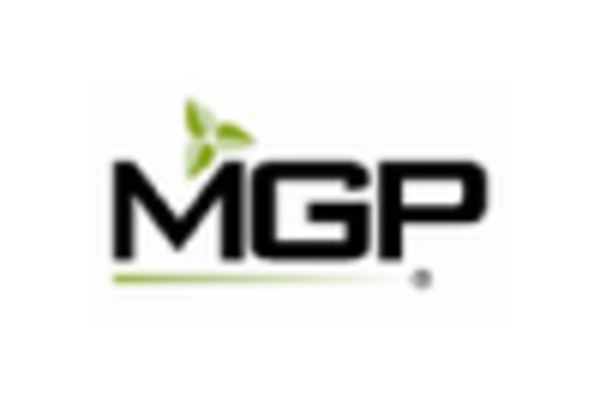Expansion of Pharmaceutical Applications
The Food-grade Ethanol Market is significantly influenced by its expanding role in the pharmaceutical sector. Ethanol is utilized as a solvent and preservative in various medicinal formulations, including tinctures and syrups. The increasing focus on health and wellness has led to a rise in the production of herbal and natural medicines, which often incorporate food-grade ethanol as a key ingredient. According to industry estimates, the pharmaceutical segment is expected to account for over 30% of the total food-grade ethanol consumption by 2025. This growth is indicative of the broader trend towards natural remedies and the increasing regulatory support for herbal products, which further propels the demand for food-grade ethanol.
Rising Consumer Awareness of Food Safety
Consumer awareness regarding food safety and quality is a driving force in the Food-grade Ethanol Market. As consumers become more informed about the ingredients in their food, there is a growing demand for products that are free from harmful additives and contaminants. Food-grade ethanol is perceived as a safer alternative, which is likely to enhance its appeal among manufacturers and consumers alike. The market is projected to grow at a compound annual growth rate of 5% over the next five years, reflecting the increasing emphasis on food safety standards. This trend suggests that food-grade ethanol will play a crucial role in ensuring product integrity and safety, thereby solidifying its position in the market.
Regulatory Support for Bio-based Products
The Food-grade Ethanol Market is positively impacted by regulatory frameworks that promote the use of bio-based products. Governments are increasingly implementing policies that encourage the adoption of renewable resources, including food-grade ethanol, as a sustainable alternative to synthetic chemicals. This regulatory support is likely to enhance market growth, as it provides incentives for manufacturers to incorporate food-grade ethanol into their products. Furthermore, the alignment of food-grade ethanol with sustainability goals may attract investments and foster innovation within the industry. As regulations continue to evolve, the food-grade ethanol market could witness a significant uptick in demand, driven by both compliance and consumer preference for eco-friendly solutions.
Increasing Use in Food and Beverage Industry
The Food-grade Ethanol Market is experiencing a notable surge in demand due to its extensive application in the food and beverage sector. Ethanol serves as a vital ingredient in various products, including flavorings, extracts, and preservatives. The market for food-grade ethanol is projected to reach approximately 5 billion liters by 2026, driven by the growing consumer preference for natural and organic products. This trend indicates a shift towards cleaner labels, where food manufacturers are increasingly opting for food-grade ethanol as a safe and effective solution. Furthermore, the rise in craft beverage production, particularly in spirits and artisanal products, is likely to bolster the demand for food-grade ethanol, thereby enhancing its market presence.
Technological Advancements in Production Processes
Technological innovations in the production of food-grade ethanol are reshaping the Food-grade Ethanol Market. Advances in fermentation technology and distillation processes have led to more efficient and cost-effective production methods. These improvements not only enhance the yield of food-grade ethanol but also reduce the environmental impact associated with its production. As a result, manufacturers are likely to benefit from lower production costs and increased profitability. The introduction of new technologies is expected to drive the market forward, with projections indicating a potential increase in production capacity by 20% over the next few years. This evolution in production techniques may also lead to a broader acceptance of food-grade ethanol across various applications.


















Leave a Comment